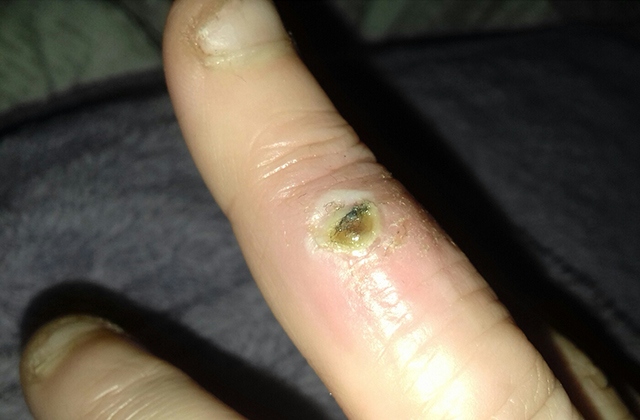Watch out for potentially dangerous spiders
Reporter: Simon Smedley
Date published: 29 April 2018
A concerned mum from Hollinwood has urged local people to be wary after she ended up paying a visit to the Royal Oldham Hospital after being bitten by a spider.
Marilyn Richards was bitten on a finger five weeks ago, at her boyfriend's home in Hathershaw, by what she believes was a potentially very dangeous, poisonous brown recluse spider, a wave of which first arrived in the UK from America two years ago.
Marilyn initially visited the Oldham Walk-In Centre after being bitten by what she describes as "the mother of all spiders".
However, after sleeplessness and illness continued for two weeks, she then decided to go to the accident and emergency department at the Royal Oldham Hospital.
Doctors confirmed Marilyn could have been bitten by a venomous brown recluse spider, and now, after treatment, she continues to recover at home.
Marilyn told the Chronicle: "The spider was huge.
"I didn't see it bite me, but I became very ill overnight.
"The pain in my finger was the worst pain I'd ever felt. It was burning, swollen and big.
"I couldn't move it.
"My daughter (11-year-old Shyanne) was bitten earlier this week in her sleep at my house.
"Luckily she wasn't bittne by a toxic spider like I was.
"Ii feel people need to be warned as these spiders are nasty things.
"The one that bit me just wasn't for dying. We tried killing it with a bottle of bleach and then hitting it with a trainer, but it wouldn't die.
"They live in clothes, bedding and things like that. They're so dangerous.
"I feel allright now, but I'm still tired a lot of the time."
Brown recluse spiders are the second most venemous spiders in the United States, after black widows.
They are normally between 6 and 20mm (0.2 and 0.8 inches) in length - but they can grow larger.
They are typically light to medium brown, but can vary in colour from whitish brown to blackish grey.
This spider's bite is often not felt immediately, but can still be serious.
Lesions tend to be red, white and blue patches - which can develop into a volcano lesion.
In severe cases, the bite will become gangrenous and can leave an open wound as large as a human hand.
It can take eight weeks or longer for a full recovery, and scars can be left as a result.
NHS England advise anyone with a bite to seek medical advice by contacting their GP or calling NHS 111 if they experience the following:
- A large area (around 10cm or more) around the bite becomes red and swollen – your GP may refer you to an allergy clinic for further tests or treatment
- You have symptoms of a wound infection, such as pus or increasing pain, swelling or redness – you may need antibiotics
- You have symptoms of a more widespread infection, such as a fever, swollen glands and other flu-like symptoms
- You’re worried about a bite or sting
- Your symptoms don’t start to improve within a few days or are getting worse
- You’ve been stung or bitten in your mouth or throat, or near your eyes.





